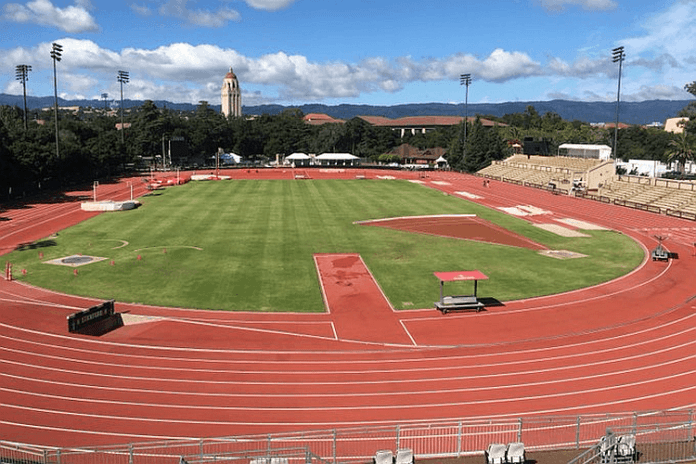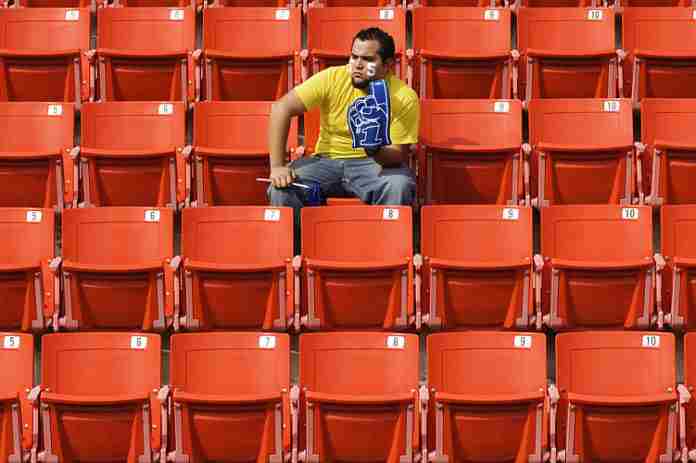≡ TSX DAILY ~ 23 August 2019 ≡
| 1. | LANE ONE: If you think track & field could once again be a high-profile sport, forget it. It’s over.
There was a time when track & field was a high-profile sport in the U.S., not too surprising since American athletes dominated the sport. But that’s not the situation today.
In its place as a headline sport has come promotional companies like Ultimate Fighting Championship (UFC), which puts on 42 cards of fights a year in Mixed Martial Arts, and which is solely devoted to bringing in more fans, more broadcasting and more money; one estimate was it had about $600 million in revenue in 2018.
What UFC and other successful entities like Major League Baseball, the National Football League, National Basketball Association and National Hockey League have in common is that they are promoters first and foremost. Attracting attention (and dollars) are what they are all about.
That’s not what governing bodies are primarily organized for, so let’s not point the finger at the International Association of Athletics Federations (IAAF) or USA Track & Field. They are not the saviors of the professional side of the sport. That must come from a promoter or promotional group, which, at present, does not exist.
In the U.S., the independent meet promoter is almost extinct. The Prefontaine Classic, run by the talented Tom Jordan, is one meet. In times past, Al Franken used to put on – out of his own pocket – four meets a year from Berkeley to San Diego, two indoors and two outdoors.
Track & field actually did have a short period of high visibility, many years ago. The old Amateur Athletic Union, then the governing body for track in the U.S., forged an agreement with CBS in 1969 and 1970 to put on one-hour meet packages on Sunday afternoons for 17 weeks in a row (each year) at a time when there were three broadcast networks in the country.
That went away, but in the ‘70s, you could still see the sport’s big stars quite often. In 1975, mile world-record setter John Walker of New Zealand ran 17 races during the year. High jumper Dwight Stones competed in 20 outdoor meets and perhaps a dozen indoors! About the same for shot put superstar Al Feuerbach. Today, the big stars like the world leaders in the 100 m (Christian Coleman), 200 m (Noah Lyles) and 400 m (Michael Norman) have run in 6-8 meets from January until today.
There are plenty of reasons why the top sports in the Olympic Games – track, swimming and gymnastics – are flops compared to the big-time professional sports like basketball and soccer worldwide. And those scenarios aren’t about to change any time soon.
The athletes themselves could change the situation, but that would require a major revolution in their attention to anything except training, travel and competition for essentially two meets a year. So let’s appreciate track & field for what it is: exciting and fun, and thanks to the Olympic Games, more widely appreciated every four years.
I’m just glad I was around to see the sport at a higher peak.
| 2. | ATHLETICS: Possible sanctions coming to Christian Coleman on “Whereabouts” failure. What is that?
One of the unpublicized aspects of being an elite athlete at the international level is drug testing.
It’s not a sometimes thing, it’s an all-the-times thing, as American sprint star Christian Coleman is finding out.
Under the protocol set up by the World Anti-Doping Agency and implemented by the U.S. Anti-Doping Agency:
“Athletes are subject to testing 365 days a year and do not have ‘off-seasons’ or cutoff periods in which testing does not occur. Whereabouts information, (dates, times, locations, etc.) is information submitted to USADA by an athlete that allows the athlete to be located for out-of-competition testing.”
Any athlete at Coleman’s level is required to submit a calendar of where he or she plans to be for three months at a time, with any changes to that schedule required to be sent to the national drug-testing organization immediately. Each athlete has this responsibility:
“Any athlete who is in the USADA RTP must provide a specific 60-minute time slot every day between 5 a.m. – 11 p.m. that anchors the athlete to a specific location. The athlete chooses the 60-minute time slot to fit their schedule and must be available and accessible for testing at a specific location during the entire 60-minute time slot. Please note that USADA can choose to, and does test athletes outside of the their 60-minute window.”
If an athlete misses providing Whereabouts information three times during a 12-month period is considered to have committed a doping violation and is subject to sanctions, just as if he or she had tested positive for a banned substance.
Testing of track & field athletes is constant and it doesn’t matter if you are in the U.S. or at a competition in a foreign country. Hotels, homes of friends, at the Pan American Games, the testers are there.
According to reports, Coleman has apparently missed three Whereabouts filings and could be sanctioned; even a one-year ban could cause him to miss both the upcoming World Championships in Qatar at the end of September and the 2020 Tokyo Olympic Games.
But it’s part of the job – an unpleasant part – of being a world-class athlete today. More details are here.
| 3. | ATHLETICS: Meeting de Paris on Saturday brings back stars Lyles, Kipruto and Holloway
The last “regular-season” meet in the IAAF Diamond League series comes Saturday at the Stade Charlety in Paris in the annual Meeting de Paris.
The focus of the meet for many of the athletes is to ensure their place in the Diamond League finals in either Zurich (SUI) or Brussels (BEL), which have significant paydays attached to them, including $50,000 to the winner and possible wild-card entries into the World Championships in Qatar.
The fields are pretty good, three athletes who haven’t been seen much could be the highlights:
● American sprint star Noah Lyles will compete for the first time since the U.S. Nationals in the 200 m. Already this season he’s run 19.50 and moved to no. 4 on the all-time list; he signaled on his Twitter feed last week that his training has been really special of late.
● Kenya’s Olympic and World Champion in the 3,000 m Steeplechase, Conseslus Kipruto, has been out all season with injuries, but is on the entry list this for Paris, along with world leader Soufiane El Bakkali of Morocco. Is he ready?
● The world leaders in the 110 m hurdles are Grant Holloway (12.98) and Daniel Roberts (13.00) from way back in June at the NCAA Championships in Austin, Texas. Roberts has run well in Europe so far, but Holloway hasn’t been seen since his 13.56-13.56-13.36 races at the U.S. Nationals, from which he barely made the U.S. Worlds team.
There are near-World Championships-caliber fields in the women’s pole vault, women’s discus and the men’s triple jump. The meet will be shown in the U.S. on NBC’s Olympic Channel on Saturday. Our preview is here.
| 4. | BASKETBALL: U.S. skips past Australia, 102-86, before 51,218 in Melbourne!
The U.S. men’s World Cup team won the first of its three exhibition games in Australia, exploding in the third quarter, turning a one-point deficit into a 12-point lead at 57-45 and then extending it from there.
The biggest lead was 20 points at 93-73 and the final margin was 16 points at 102-86. Kemba Walker led the U.S. with 23 points – 22 in the second half – and the U.S. had six men in double figures. Guards Patty Mills and Chris Goulding led Australia with 19 each.
The U.S. once again had a huge rebounding edge, 54-36 and shot 48% from the field to just 40% for the hosts. Even better, U.S. turnovers were down from 23 vs. Spain to just 13.
Marvel Stadium is normally used for Australian Rules Football, but a court was installed in the middle of the field and the game attracted the largest crowd for basketball in Australian history. The two teams will play again, in the same venue, on Saturday. More details here.
| 5. | JUDO: Tokyo hosts 2019 World Championships at the famed Nippon Budokan
The site where Olympic judo first took place during the 1964 Tokyo Games – the Nippon Budokan – will host the International Judo Federation’s World Championships this weekend, with the host team ready to post a dominating performance.
Japan has led the medal table in each and every one of the World Championships in which men and women have competed together, starting in 1987; that’s 19 in a row. Among the Japanese stars in action will be:
● Men/60 kg: Naohisa Takato, trying for his fourth World Championship
● Men/66 kg: Hifumi Abe (pictured), trying for his third straight World Championship
● Women/70 kg: Chizuru Arai, trying for her third straight World Championship
In the women’s -63 kg division, France’s Clarisse Agbegnenou will be trying for her third straight world title in this weight class. Our in-depth preview is here.
| 6. | SWIMMING: Best tickets for 2020 U.S. Olympic Trials sold out; smaller packages now available
Tickets in the entire lower bowl of the CHI Health Center in Omaha, Nebraska for the 2020 USA Swimming Olympic Trials have been sold out. These packages were priced at up to $575 for all 15 sessions of the Trials, from 21-28 June next year.
That’s ahead of the sales pace for the 2016 Trials, which eventually sold out completely. The Omaha Sports Commission said that 80% of the ticket buyers were from the Omaha area.
In order to advance the remaining sales, four-day ticket packages priced from $220-275 for the final seven sessions of the Trials are now being sold. All-session packages starting at $375, are still available.
| 7. | PARA-ROWING: Belarus rower drowns in tragic accident at rowing Worlds
Para rower Dzmitry Ryshkevich of Belarus, 33, drowned when his boat capsized during a training session at the site of the World Rowing Championships in Linz-Ottensheim, Austria on Wednesday (21st).
He was an experienced performer in the Single Sculls, but the pontoon stabilizer on his craft came apart and the boat turned over around 1:15 p.m. The local police statement explained:
“When the rescue boat with a lifesaver on board approached, the rower was still holding on to his boat but subsequently let go, sinking under water. Despite immediate rescue activities, the rower could not be found. The murky water at the location is approximately 2.40m [7-10 1/2] deep with almost no visibility.
“Rescue divers were called in and started an extended search. At about 4 p.m. the rower was found under water in close proximity to where the capsize happened. The doctor at the scene was only able to pronounce the rower dead.”
An investigation is continuing; our condolences to his family and especially his teammates.
| 8. | THE LAST WORD: Norway’s Faugstad calls news media a source of stress at World Youth Champs
The World Archery Youth Championships has reached the medal-match stage in Madrid, Spain, with 19-year-old Anders Faugstad of Norway safely into the finals in the men’s Junior Compound division against Canada’s Austin Taylor.
That’s not really a surprise, as Faugstad won the World Championships silver medal earlier this year, beating many more experienced shooters. But asked about his performance after his tight semi-final win over Cooper French of the U.S., 147-146, he said:
“I feel relieved. It’s been a lot of stress for me getting to the gold medal match after I was the runner-up at the World Championships in the Netherlands. People write articles about me. I don’t read them, but I know they’re written and it puts pressure on me.”
Faugstad’s stance on the media is interesting, since many athletes say that what makes massive events like the Olympic Games so special is the mass of news media and the increased attention that they receive. Then again, as a Compound shooter, his event isn’t in the Games!


























